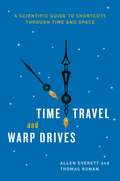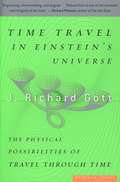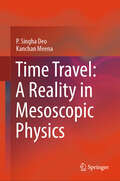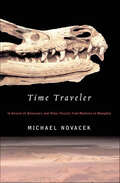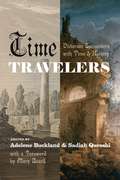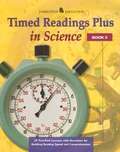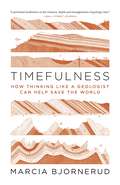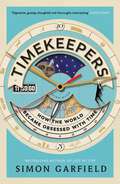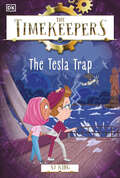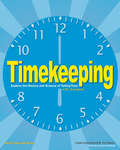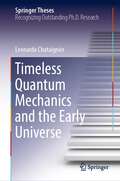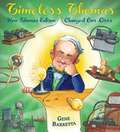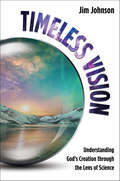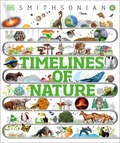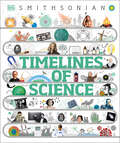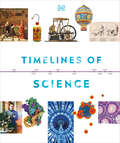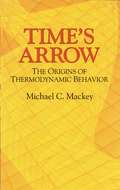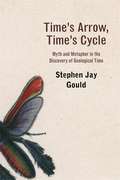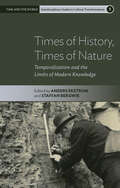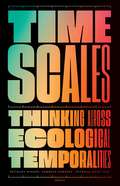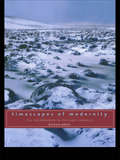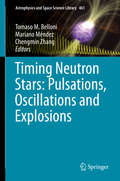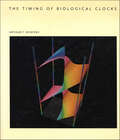- Table View
- List View
Time Travel and Warp Drives: A Scientific Guide to Shortcuts through Time and Space
by Allen Everett Thomas RomanTo see video demonstrations of key concepts from the book, please visit this website: http://www.press.uchicago.edu/sites/timewarp/ Sci-fi makes it look so easy. Receive a distress call from Alpha Centauri? No problem: punch the warp drive and you're there in minutes. Facing a catastrophe that can't be averted? Just pop back in the timestream and stop it before it starts. But for those of us not lucky enough to live in a science-fictional universe, are these ideas merely flights of fancy—or could it really be possible to travel through time or take shortcuts between stars? Cutting-edge physics may not be able to answer those questions yet, but it does offer up some tantalizing possibilities. In Time Travel and Warp Drives, Allen Everett and Thomas A. Roman take readers on a clear, concise tour of our current understanding of the nature of time and space—and whether or not we might be able to bend them to our will. Using no math beyond high school algebra, the authors lay out an approachable explanation of Einstein's special relativity, then move through the fundamental differences between traveling forward and backward in time and the surprising theoretical connection between going back in time and traveling faster than the speed of light. They survey a variety of possible time machines and warp drives, including wormholes and warp bubbles, and, in a dizzyingly creative chapter, imagine the paradoxes that could plague a world where time travel was possible—killing your own grandfather is only one of them! Written with a light touch and an irrepressible love of the fun of sci-fi scenarios—but firmly rooted in the most up-to-date science, Time Travel and Warp Drives will be a delightful discovery for any science buff or armchair chrononaut.
Time Travel in Einstein's Universe: The Physical Possibilities of Travel Through Time
by J. Richard GottA Princeton astrophysicist explores whether journeying to the past or future is scientifically possible in this &“intriguing&” volume (Neil deGrasse Tyson). It was H. G. Wells who coined the term &“time machine&”—but the concept of time travel, both forward and backward, has always provoked fascination and yearning. It has mostly been dismissed as an impossibility in the world of physics; yet theories posited by Einstein, and advanced by scientists including Stephen Hawking and Kip Thorne, suggest that the phenomenon could actually occur. Building on these ideas, J. Richard Gott, a professor who has written on the subject for Scientific American, Time, and other publications, describes how travel to the future is not only possible but has already happened—and contemplates whether travel to the past is also conceivable. This look at the surprising facts behind the science fiction of time travel &“deserves the attention of anyone wanting wider intellectual horizons&” (Booklist). &“Impressively clear language. Practical tips for chrononauts on their options for travel and the contingencies to prepare for make everything sound bizarrely plausible. Gott clearly enjoys his subject and his excitement and humor are contagious; this book is a delight to read.&” —Publishers Weekly
Time Travel: A Reality in Mesoscopic Physics
by P. Singha Deo Kanchan MeenaThis book is aimed at postgraduate and Ph.D. students specializing in condensed matter physics, quantum mechanics, and the theory of relativity. It explores fundamental problems in physics that can be addressed in the mesoscopic regime. Some of the key topics covered include: a) The state of a tunneling particle under a barrier b) A local description of the state of a quantum particle c) Reality of time travel leading to reconciliation of the classical and quantum laws The book also sets the stage for developing an alternative description of quantum mechanics and how scattering phase shift can be used to probe local density of states. It highlights essential differences from traditional statistical mechanics and discusses the potential applications and future technologies stemming from breakthroughs in basic science, which will be of interest to researchers.
Time Traveler: In Search of Dinosaurs and Other Fossils from Montana to Mongolia
by Michael NovacekTrue stories of fossil-hunting adventures around the globe from “a world-class field scientist [and] a highly entertaining writer” (The American Scholar).Michael Novacek, a world-renowned paleontologist who has discovered important fossils on virtually every continent, is an authority on patterns of evolution and on the relationships among extinct and extant organisms. Time Traveler is his captivating account of how his boyhood enthusiasm for dinosaurs became a lifelong commitment to vanguard science. He takes us with him as he discovers fossils in his own backyard in Los Angeles, then goes looking for them in the high Andes, the black volcanic mountains of Yemen, and the incredibly rich fossil badlands of the Gobi Desert.Wherever Novacek goes, he searches for still-undiscovered evidence of what life was like on Earth millions of years ago. Along the way he has almost drowned, been stung by deadly scorpions, been held at gunpoint by a renegade army, and nearly choked in raging dust storms. Fieldwork is very demanding in a host of unusual, dramatic, sometimes hilarious ways, and Novacek writes of its alluring perils with affection and discernment. But in addition to being an enthralling adventure story, Time Traveler makes sense of many complex themes—about dinosaur evolution, continental drift, mass extinctions, new methods for understanding ancient environments, and the evolutionary secrets of DNA in fossil organisms.Includes photos and illustrations“A superb introduction to paleontology.” —Edward O. Wilson“An engaging book [that] gives us an excellent sense of the way paleontologists have arrived at their world-shaking conclusions.” —The New York Times Book Review“Novacek offers a spellbinding natural history of our planet, as well as the equally fascinating story of how he fell into the profession.” —Publishers Weekly
Time Travelers: Victorian Encounters with Time and History
by Adelene Buckland Sadiah QureshiThe Victorians, perhaps more than any Britons before them, were diggers and sifters of the past. Though they were not the first to be fascinated by history, the intensity and range of their preoccupations with the past were unprecedented and of lasting importance. The Victorians paved the way for our modern disciplines, discovered the primeval monsters we now call the dinosaurs, and built many of Britain’s most important national museums and galleries. To a large degree, they created the perceptual frameworks through which we continue to understand the past. Out of their discoveries, new histories emerged, giving rise to fresh debates, while seemingly well-known histories were thrown into confusion by novel tools and methods of scrutiny. If in the eighteenth century the study of the past had been the province of a handful of elites, new technologies and economic development in the nineteenth century meant that the past, in all its brilliant detail, was for the first time the property of the many, not the few. Time Travelers is a book about the myriad ways in which Victorians approached the past, offering a vivid picture of the Victorian world and its historical obsessions.
Time Warped: Unlocking the Mysteries of Time Perception
by Claudia HammondWe are obsessed with time. However hard we might try, it is almost impossible to spend even one day without the marker of a clock. But how much do we understand about time, and is it possible to retrain our brains and improve our relationship with it? Drawing on the latest research from the fields of psychology, neuroscience, and biology, and using original research on the way memory shapes our understanding of time, acclaimed writer and broadcaster Claudia Hammond delves into the mysteries of time perception. Along the way, she introduces us to an extraordinary array of colourful characters willing to go to great lengths in the interests of research, such as the French speleologist Michel, who spends two months in an ice cave in complete darkness. Time Warped shows us how to manage our time more efficiently, speed time up and slow it down at will, plan for the future with more accuracy, and, ultimately, use the warping of time to our own advantage.
Time Warped: Unlocking the Mysteries of Time Perception
by Claudia HammondAn award–winning BBC podcast host “has a steady touch . . . adding user-friendly charm” to “intriguing” research on the psychology of time perception (New York Times).Why does life seem to speed up as we get older? Why does the clock in your head move at a different speed from the one on the wall? Why is it almost impossible to go a whole day without checking your watch? Is it possible to retrain our brains and improve our relationship with it? In Time Warped, Claudia Hammond offers insight into how to manage our time more efficiently, how to speed time up and slow it down at will, how to plan for the future with more accuracy, and she teaches how to use the warping of time to our own benefit.“An ideal read for those looking for science-based theories of time perception without the scientific jargon. . . . Hammond demonstrates how life’s circumstances can make minutes seem an eternity and decades the blink of an eye.” —Library Journal“A well-researched meditation on how we see the future.” —Slate“This lively introduction to the psychology of time perception is an intriguing take on the fluidity of reality.” —Publishers Weekly“. . . a fascinating foray into the idea that our experience of time is actively created by our own minds and how these sensations of what neuroscientists and psychologists call “mind time” are created.” —Maria Popova, The Marginalian
Timed Readings Plus In Science: 25 Two-part Lessons With Questions For Building Reading Speed And Comprehension
by Mcgraw-Hill Jamestown Education StaffDo your students fail to even finish a timed test? Do they read word by word? Do they simply move their eyes over the page, never remembering what they read? If you suspect that students' test scores are being confounded by any of these traits, or if you have students who need to process greater amounts of information, the Timed Readings books can help. For over thirty years, Jamestown has been helping students increase their reading rate and fluency while maintaining comprehension. Timed Readings Plus in Science features 400-word nonfiction timed passages on current science topics, similar to those found on state and national tests.
Timefulness: How Thinking Like a Geologist Can Help Save the World
by Marcia BjornerudWhy an awareness of Earth’s temporal rhythms is critical to our planetary survivalFew of us have any conception of the enormous timescales in our planet’s long history, and this narrow perspective underlies many of the environmental problems we are creating for ourselves. The passage of nine days, which is how long a drop of water typically stays in Earth’s atmosphere, is something we can easily grasp. But spans of hundreds of years—the time a molecule of carbon dioxide resides in the atmosphere—approach the limits of our comprehension. Our everyday lives are shaped by processes that vastly predate us, and our habits will in turn have consequences that will outlast us by generations. Timefulness reveals how knowing the rhythms of Earth’s deep past and conceiving of time as a geologist does can give us the perspective we need for a more sustainable future.Marcia Bjornerud shows how geologists chart the planet’s past, explaining how we can determine the pace of solid Earth processes such as mountain building and erosion and comparing them with the more unstable rhythms of the oceans and atmosphere. These overlapping rates of change in the Earth system—some fast, some slow—demand a poly-temporal worldview, one that Bjornerud calls “timefulness.” She explains why timefulness is vital in the Anthropocene, this human epoch of accelerating planetary change, and proposes sensible solutions for building a more time-literate society.This compelling book presents a new way of thinking about our place in time, enabling us to make decisions on multigenerational timescales. The lifespan of Earth may seem unfathomable compared to the brevity of human existence, but this view of time denies our deep roots in Earth’s history—and the magnitude of our effects on the planet.
Timekeepers: How the World Became Obsessed with Time
by Simon GarfieldBy the bestselling author of Just My Type: a &“thoroughly enjoyable and illuminating&” journey into the concept of time &“stuffed with fascinating material&” (Observer, UK).Timekeepers is a book about our obsession with time and our desire to measure it, control it, sell it, film it, perform it, immortalize it and make it meaningful. In this fascinating, anecdotal exploration, award-winning author Simon Garfield has two simple intentions: to tell some illuminating stories, and to ask whether we have all gone completely nuts. Here, Garfield explores the nature of time through stories such as: the Beatles learning to be brilliant in an hour and a half; an Englishman arriving back from Calcutta, refusing to adjust his watch; Beethoven&’s symphonic wishes being ignored; a US Senator&’s speech that goes for 25 hours; the horrors of war frozen at the click of a camera; a woman who designs a ten-hour clock and reinvents the calendar; Roger Bannister living out the same four minutes over a lifetime; and a who prince attempts to stop time in its tracks.&“Digressive, gossipy, thoughtful and thoroughly entertaining.&”—The Sunday Times, UK
The Timekeepers: The Tesla Trap (Timekeepers )
by SJ KingThe Timekeepers are a secret organization of kids who keep the course of history on track. And history needs them—a villain called DeLay is causing chaos!When the hands on their watches start to spin backward, the Timekeepers know that DeLay has been up to no good, and it's up to them to put things right...In this installment, the Timekeepers travel back to 1890s New York City and the laboratory of Nikola Tesla. On the eve before Tesla is set to reveal his latest invention, the X-Ray Machine, the time pirate DeLay, disguised as Tesla's rival Thomas Edison, steals the machine. The Timekeepers begin a pursuit around New York City in search of the machine to ensure history stays on track. With a range of adventures that span all of history, The Timekeepers series is perfect for any adventure lover.
Timekeeping
by Sam Carbaugh W Eric Martin Linda FormichelliTimekeeping: Explore the History and Science of Telling Time travels through the past and into the future to explore how humans have measured the passage of time. From ancient civilization's earliest calendars and shadow clocks to GPS and the atomic clocks of today, kids will track the evolution of timekeeping devices, meet the inventors of calendars and clocks, and learn interesting facts and trivia. Hands-on projects and activities include making a shadow clock, using a protractor to create a sundial, measuring time using water, and creating your own calendar. Kids will understand how civilization's vague abilities to track days and months has transformed over the centuries into a sophisticated ability to keep time to the millionth of a second.
Timeless Quantum Mechanics and the Early Universe (Springer Theses)
by Leonardo ChataignierThe book is based on the author's PhD thesis, which deals with the concept of time in quantum gravity and its relevance for the physics of the early Universe. It presents a consistent and complete new relational formulation of quantum gravity (more specifically, of quantum mechanics models with diffeomorphism invariance), which is applied to potentially observable cosmological effects. The work provides answers to the following questions: How can the dynamics of quantum states of matter and geometry be defined in a diffeomorphism-invariant way? What is the relevant space of physical states and which operators act on it? How are the quantum states related to probabilities in the absence of a preferred time? The answers can provide a further part of the route to constructing a fundamental theory of quantum gravity. The book is well-suited to graduate students as well as professional researchers in the fields of general relativity and gravitation, cosmology, and quantum foundations.
Timeless Thomas: How Thomas Edison Changed Our Lives
by Gene BarrettaWhat do record players, batteries, and movie cameras have in common? All these devices were created by the man known as The Wizard of Menlo Park: Thomas Edison. Edison is most famous for inventing the incandescent lightbulb, but at his landmark laboratories in Menlo Park & West Orange, New Jersey, he also developed many other staples of modern technology. Despite many failures, Edison persevered. And good for that, because it would be very difficult to go through a day without using one of his life-changing inventions. In this enlightening book, Gene Barretta enters the laboratories of one of America's most important inventors.
Timeless Vision: Understanding God's Creation through the Lens of Science
by Jim JohnsonFaith and facts are reconciled in this revelatory examination of biblical and secular truths that follows the path to God through science, not around it. Always a man of science, Jim Johnson accepted Christ into his life shortly after his fiftieth birthday. This acceptance of God&’s unseeable power did not shake his belief in science—it strengthened it. Through years of research on the world&’s evolution, Johnson found that in studying every new hypothesis and theory, he believes even more in God&’s universal role.Timeless Vision: Understanding God&’s Creation through the Lens of Science bridges the gap between faith and science. Johnson examines the natural progression of Earth&’s creation alongside the seven biblical days, explains the conundrum of time, and expands upon the ever-evolving relationship humanity has with science and religion. Through analyzing scripture with detailed data and using science to bolster Christian beliefs, Johnson reveals just how rare and privileged Earth and human life truly are. It is through studying science and faith together, not apart, that we can see how God&’s plan was developed and why He did it. One is not complete without the other. Let Johnson lead you down the path less traveled—the one of science and faith—and show how God gave humanity these ways to discover Him more fully and completely.
Timelines of Nature: From Mountains and Glaciers to Mayflies and Marsupials (DK Children's Timelines)
by DKDiscover the fascinating history of our planet with this unique collection of visual timelines. Full of exciting visual timelines covering minutes, hours, days, weeks, months, and years, Timelines of Nature reveals our planet&’s natural history and its life cycles in an entirely new way. Beginning at our world&’s existence; children aged 9+ will learn how many years it took the Moon to form and witness Earth&’s continents collide. Discover the history of Earth&’s most spectacular features – from the Grand Canyon to the Sahara desert. See how life evolved, from the first single-celled organisms to the extraordinary variety of creatures living today. Then we look at life on Earth today. Every species on Earth has its own unique story – Timelines of Nature reveals these weird and wonderful life cycles through fascinating visual timelines. It tells you what&’s really happening on Earth each minute of every day. This beautiful nature book for children features: - Beautiful timelines teach young readers all about geology, plants, and animals.- Each timeline is unique and depicts a different topic, such as the story of how whales evolved, how the Moon was formed, or how a tiger spends its day.- Feature pages highlight climactic moments in nature, for example, the butterfly finally emerging from its chrysalis.- Supporting educational boxes on each page explain key points about nature, helping kids to discover more about the world around them.Children can marvel at a variety of different timeframes in nature, like geological timelines spanning thousands of years; a year in the life of a habitat, a day in the life of an animal, and complete plant life cycles. Ever wondered what the mayfly does with its short life? In this book, you&’ll find out how it lives as a nymph for two weeks, before flying out of the water for just a day in the sky as a mayfly. If you&’ve ever thought about how a chimpanzee spends its day, how the rainforest changes over 24 hours, or how long a kangaroo&’s pregnancy lasts, then this is the book for you! Explore the series!If you like Timelines of Nature, why not check out other our exciting titles in the Timelines series? Explore the unique collection of visual timelines which bring big topics to life. Discover leaders, legends and legacies in Timelines of Black History, uncover the past from woolly mammoths to World Wars in Timelines of Everything and explore key milestones and breakthroughs with Timelines of Science.
Timelines of Science (DK Children's Timelines)
by Leo Ball Patricia FaraFrom the wheel to the worldwide web, our planet has been transformed by science.Now you can travel through time to experience centuries of invention and innovation on this spectacular visual voyage of discovery. Starting in ancient times and ending up in the modern world, you&’ll explore scientific history showcased in stunning images and captivating text. An easy-to-follow illustrated timeline runs throughout the book, keeping you informed of big breakthroughs and key developments. Get to grips with revolutionary ideas like measuring time or check out amazing artifacts like flying machines. Great geniuses, including Marie Curie, Albert Einstein, and Charles Darwin are introduced alongside their most important ideas and inventions, all shown in glorious detail. Hundreds of pages of history are covered in Timelines of Science, with global coverage of scientific advances. Whether you're joining in with eureka moments, inspecting engines, or learning about evolution, all aspects of science are covered from the past, present, and future.
Timelines of Science (DK Timelines)
by DKFrom the wheel to the worldwide web, our planet has been transformed by science.Now you can travel through time to experience centuries of invention and innovation on this spectacular visual voyage of discovery. Starting in ancient times and ending up in the modern world, you&’ll explore scientific history showcased in stunning images and captivating text. An easy-to-follow illustrated timeline runs throughout the book, keeping you informed of big breakthroughs and key developments. Get to grips with revolutionary ideas like measuring time or check out amazing artifacts like flying machines. Great geniuses, including Marie Curie, Albert Einstein, and Charles Darwin are introduced alongside their most important ideas and inventions, all shown in glorious detail. Hundreds of pages of history are covered in Timelines of Science, with global coverage of scientific advances. Whether you're joining in with eureka moments, inspecting engines, or learning about evolution, all aspects of science are covered from the past, present, and future.
Time's Arrow: The Origins of Thermodynamic Behavior
by Michael C. MackeyExploration of Second Law of Thermodynamics details fundamental dynamic properties behind construction of statistical mechanics. Topics include maximal entropy principles; invertible and noninvertible systems; ergodicity and unique equilibria; and asymptotic periodicity and entropy evolution. Geared toward physicists and applied mathematicians; suitable for advanced undergraduate and graduate courses. 1992 edition.
Time’s Arrow, Time’s Cycle: Myth and Metaphor in the Discovery of Geological Time (The Jerusalem-Harvard lectures)
by Stephen Jay GouldRarely has a scholar attained such popular acclaim merely by doing what he does best and enjoys most. But such is Stephen Jay Gould’s command of paleontology and evolutionary theory, and his gift for brilliant explication, that he has brought dust and dead bones to life, and developed an immense following for the seeming arcana of this field. In Time’s Arrow, Time’s Cycle his subject is nothing less than geology’s signal contribution to human thought—the discovery of “deep time,” the vastness of earth’s history, a history so ancient that we can comprehend it only as metaphor. He follows a single thread through three documents that mark the transition in our thinking from thousands to billions of years: Thomas Burnet’s four-volume Sacred Theory of the Earth (1680–1690), James Hutton’s Theory of the Earth (1795), and Charles Lyell’s three-volume Principles of Geology (1830–1833). Gould’s major theme is the role of metaphor in the formulation and testing of scientific theories—in this case the insight provided by the oldest traditional dichotomy of Judeo-Christian thought: the directionality of time’s arrow or the immanence of time’s cycle. Gould follows these metaphors through these three great documents and shows how their influence, more than the empirical observation of rocks in the field, provoked the supposed discovery of deep time by Hutton and Lyell. Gould breaks through the traditional “cardboard” history of geological textbooks (the progressive march to truth inspired by more and better observations) by showing that Burnet, the villain of conventional accounts, was a rationalist (not a theologically driven miracle-monger) whose rich reconstruction of earth history emphasized the need for both time’s arrow (narrative history) and time’s cycle (immanent laws), while Hutton and Lyell, our traditional heroes, denied the richness of history by their exclusive focus upon time’s arrow.
Times of History, Times of Nature: Temporalization and the Limits of Modern Knowledge (Time and the World: Interdisciplinary Studies in Cultural Transformations #5)
by Staffan Bergwik Anders EkströmAs climate change becomes an increasingly important part of public discourse, the relationship between time in nature and history is changing. Nature can no longer be considered a slow and immobile background to human history, and the future can no longer be viewed as open and detached from the past. Times of History, Times of Nature engages with this historical shift in temporal sensibilities through a combination of detailed case studies and synthesizing efforts. Focusing on the history of knowledge, media theory, and environmental humanities, this volume explores the rich and nuanced notions of time and temporality that have emerged in response to climate change.
Timescales: Thinking across Ecological Temporalities
by Bethany Wiggin Carolyn Fornoff Patricia Eunji KimHumanists, scientists, and artists collaborate to address the disjunctive temporalities of ecological crisis In 2016, Antarctica&’s Totten Glacier, formed some 34 million years ago, detached from its bedrock, melted from the bottom by warming ocean waters. For the editors of Timescales, this event captures the disjunctive temporalities of our era&’s—the Anthropocene&’s—ecological crises: the rapid and accelerating degradation of our planet&’s life-supporting environment established slowly over millennia. They contend that, to represent and respond to these crises (i.e., climate change, rising sea levels, ocean acidification, species extinction, and biodiversity loss) requires reframing time itself, making more visible the relationship between past, present, and future, and between a human life span and the planet&’s. Timescales&’ collection of lively and thought-provoking essays puts oceanographers, geophysicists, geologists, and anthropologists into conversation with literary scholars, art historians, and archaeologists. Together forging new intellectual spaces, they explore the relationship between geological deep time and historical particularity, between ecological crises and cultural expression, between environmental policy and social constructions, between restoration ecology and future imaginaries, and between constructive pessimism and radical (and actionable) hope. Interspersed among these essays are three complementary &“etudes,&” in which artists describe experimental works that explore the various timescales of ecological crisis. Contributors: Jason Bell, Harvard Law School; Iemanjá Brown, College of Wooster; Beatriz Cortez, California State U, Northridge; Wai Chee Dimock, Yale U; Jane E. Dmochowski, U of Pennsylvania; David A. D. Evans, Yale U; Kate Farquhar; Marcia Ferguson, U of Pennsylvania; Ömür Harmanşah, U of Illinois at Chicago; Troy Herion; Mimi Lien; Mary Mattingly; Paul Mitchell, U of Pennsylvania; Frank Pavia, California Institute of Technology; Dan Rothenberg; Jennifer E. Telesca, Pratt Institute; Charles M. Tung, Seattle U.
Timescapes of Modernity: The Environment and Invisible Hazards (Global Environmental Change Ser.)
by Barbara AdamTimescapes of Modernity explores the relationship between time and environmental and socio-cultural concerns. Using examples such as the BSE crisis, the Sea Empress oil pollution and the Chernobyl radiation Barbara Adam argues that environmental hazards are inescapably tied to the successes of the industrial way of life. Global markets and economic growth; large-scale production of food; the speed of transport and communication; the 24 hour society and even democratic politics are among the invisible hazards we face. With this unique 'timescape' perspective the author dislodges assumptions about environmental change, enables a rethinking of environmental problems and provides the potential for new strategies to deal with environmental hazards.
Timing Neutron Stars: Pulsations, Oscillations and Explosions (Astrophysics and Space Science Library #461)
by Tomaso M. Belloni Mariano Méndez Chengmin ZhangNeutron stars, whether isolated or in a binary system, display a varied and complex phenomenology, often accompanied by extreme variability of many time scales, which takes the form of pulsations due to the object rotation, quasi-periodicities associated to accretion of matter, and explosions due to matter accreted on the surface or to starquakes of highly magnetized objects.This book gives an overview of the current observational and theoretical standpoint in the research on the physics under the extreme conditions that neutron stars naturally provide. The six chapters explore three physical regions of a neutron star:the space around it, where accretion and pulsar companions allow testing of general relativityits surface, where millisecond pulsation and X-ray burts provide clues about general relativistic effects and the equation of state of neutron matterits interior, of course, inaccessible to direct observations, can nevertheless, be probed with all observational parameters related to neutron star variability.
Timing of Biological Clocks
by Arthur T. Winfree"A clock," writes Arthur T. Winfree, "is not much good if you can't pull out its stem and set it."Similarly, the most critical property of biological clocks--which rhythmically organize the processes of life--is their ability to reset on cue.This ability allows enables biological clocks to regain synchrony with a changing environment (as when we travel across time zones) or to maintain the alignment between certain physiological rhythms and the natural solar day.In The Timing of Biological Clocks, Winfree explores circadian rhythms. In reporting experiments on animals, plants, and single cells, he not only illustrates the principles that guide the resetting of biological clocks but reveals that each of these clocks has a vulnerable phase, a moment in each "turn of the dial" when a cueing stimulus of a particular intensity results in an abnormal, unpredictable resetting--perhaps even annihilating the clock's rhythm entirely.A singular feature of the author's exploration of these phenomena is his use of a range of colors to represent the passage of cyclic time. By this device, Winfree not only removes the purely arbitrary discontinuity of a conventional clock dial but makes reasoning about the real discontinuities of biological clocks transparently clear.
